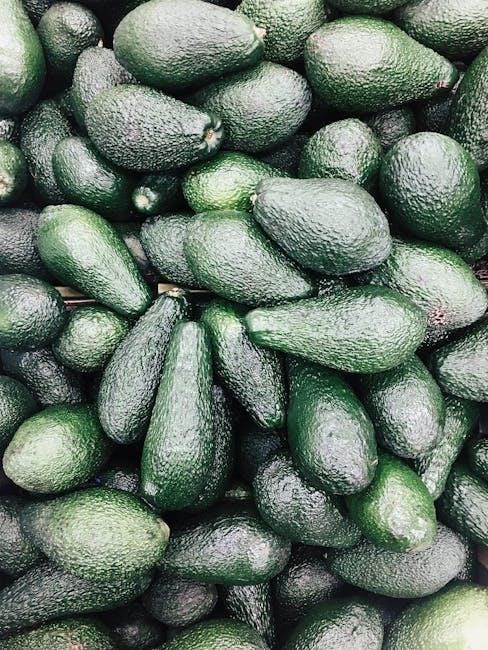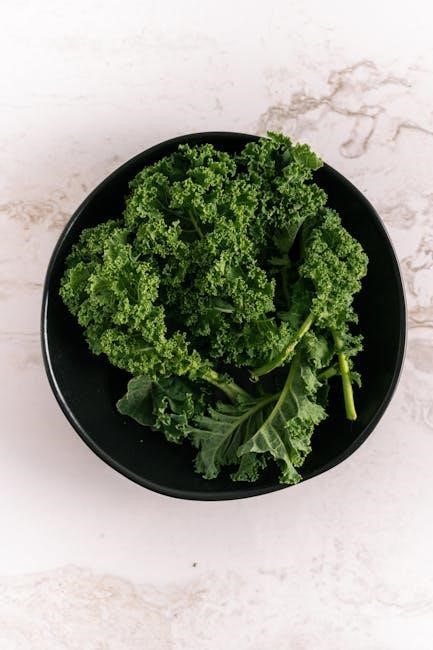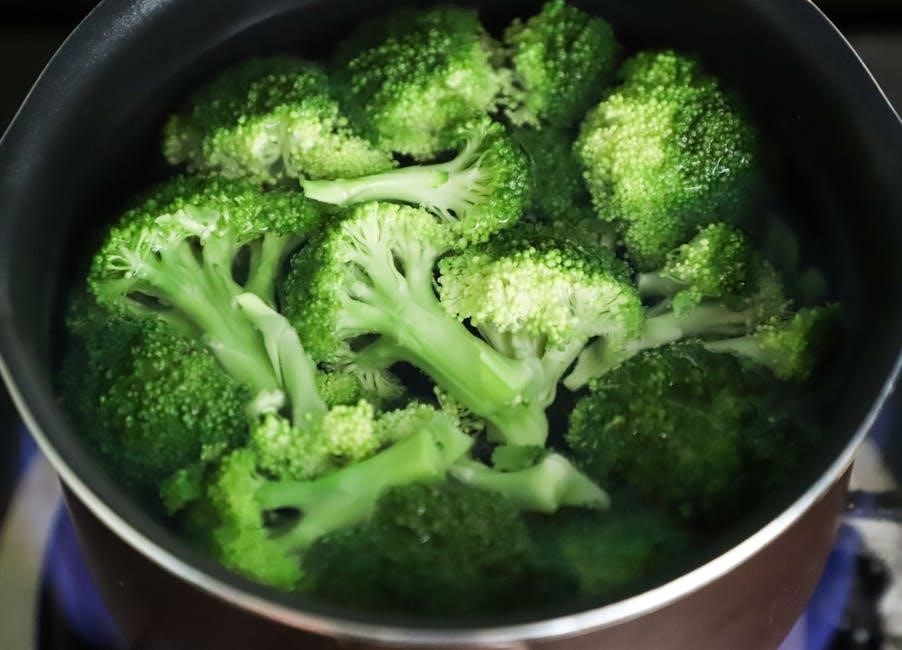The vegetarian keto diet combines low-carb, high-fat eating with plant-based nutrition, offering a structured approach to weight loss and improved health. This diet is a sustainable lifestyle choice.
1.1 What is a Vegetarian Keto Diet?
A Vegetarian Keto Diet is a dietary approach that merges the principles of vegetarianism with the ketogenic diet, focusing on plant-based, low-carb, high-fat foods to achieve ketosis. It excludes meat, fish, and poultry, relying on sources like tofu, eggs, and healthy fats to maintain nutritional balance and promote weight loss while adhering to ethical or environmental preferences.
1.2 Benefits of Combining Vegetarian and Keto Diets
Combining a vegetarian and keto diet offers numerous benefits, including weight loss, improved blood sugar control, and reduced inflammation. It promotes high intake of fiber, vitamins, and minerals from plant-based foods while maintaining the metabolic advantages of ketosis. This approach also supports ethical and environmental choices by eliminating animal products, making it a sustainable and compassionate lifestyle option.
1.3 Importance of Meal Planning for Success
Meal planning is crucial for a successful vegetarian keto diet. It ensures you stay in ketosis by tracking macronutrients and avoiding hidden carbs. A well-structured plan prevents last-minute, unhealthy choices and saves time. It also helps manage protein intake and provides a clear roadmap for grocery shopping, making the diet sustainable and easier to follow long-term.

Key Principles of a Vegetarian Keto Diet
The vegetarian keto diet focuses on high-fat, low-carb, and moderate-protein intake, emphasizing plant-based foods to induce ketosis for weight loss and improved health outcomes.
2.1 Understanding Ketosis and Its Role in Weight Loss
Ketosis is a metabolic state where your body burns fat for fuel instead of carbohydrates, promoting significant weight loss. A vegetarian keto diet triggers ketosis by drastically reducing carb intake, forcing the body to rely on stored fats. This process not only aids in shedding pounds but also reduces hunger and boosts energy levels naturally.
2.2 Macronutrient Breakdown: Fats, Proteins, and Carbs
A vegetarian keto diet emphasizes a macronutrient breakdown of 70-80% fats, 15-20% protein, and 5-10% net carbs. Healthy fats like avocados and nuts fuel ketosis, while moderate protein from tofu and eggs supports muscle health. Low-carb vegetables and minimal sugar intake keep the diet aligned with ketogenic principles, ensuring sustained weight loss and metabolic balance.
2.3 Foods to Eat and Avoid on a Vegetarian Keto Diet
The vegetarian keto diet focuses on low-carb, high-fat, and moderate-protein foods. Emphasize healthy fats like avocados, nuts, and seeds, along with protein sources such as tofu, tempeh, and eggs. Include low-carb vegetables like spinach, broccoli, and cauliflower. Avoid high-carb foods, legumes, starchy vegetables, and sugary fruits to maintain ketosis and support weight loss effectively.
Sample 7-Day Vegetarian Keto Meal Plan
This meal plan provides a balanced mix of low-carb, high-fat vegetarian meals, including breakfast, lunch, dinner, and snacks, designed to keep you in ketosis while offering variety and flavor.
3.1 Day 1: Breakfast, Lunch, Dinner, and Snacks
Breakfast: Three Cheese Quiche with spinach and mushrooms, offering 245.5 calories, 16.3g fat, 5.9g net carbs, and 7.8g protein.
Lunch: Keto Grilled Cheese Sandwich with 503 calories, 37g fat, 5.9g net carbs, and 12.3g protein.
Dinner: Stuffed Bell Peppers with cauliflower rice, providing 432 calories, 32.4g fat, 8.5g net carbs, and 15.6g protein.
Snacks: Mozzarella cheese slices, totaling 140 calories, 11.3g fat, 1.2g net carbs, and 6.3g protein.
This meal plan balances flavors and nutrients, keeping you in ketosis while satisfying your appetite.
3.2 Day 2: Balanced Meals with Macronutrient Details
Breakfast: Scrambled tofu with spinach and avocado, providing 320 calories, 24g fat, 4g net carbs, and 12g protein.
Lunch: Cauliflower rice bowl with grilled portobello mushrooms, totaling 450 calories, 35g fat, 6g net carbs, and 15g protein.
Dinner: Zucchini boats stuffed with ricotta and Parmesan, offering 380 calories, 28g fat, 5g net carbs, and 14g protein.
Snacks: Celery sticks with almond butter, delivering 180 calories, 16g fat, 2g net carbs, and 4g protein.
This day emphasizes variety and nutrient balance, ensuring ketosis is maintained while meeting dietary needs.
3.3 Day 3: Creative Recipes for Variety
Breakfast: Stuffed bell peppers with scrambled eggs and cheese, offering 300 calories, 22g fat, 4g net carbs, and 12g protein.
Lunch: Zucchini noodles with pesto sauce and pine nuts, totaling 400 calories, 34g fat, 5g net carbs, and 8g protein.
Dinner: Grilled eggplant parmesan with a side salad, providing 420 calories, 30g fat, 6g net carbs, and 15g protein.
Dessert: Keto chocolate mousse made with avocado and cocoa powder, delivering 200 calories, 18g fat, 2g net carbs, and 3g protein.
These creative dishes add variety while maintaining ketosis and nutritional balance.

Protein Sources for Vegetarian Keto Diets
Key protein sources include tofu, tempeh, nuts, seeds, and eggs, providing essential amino acids while maintaining ketosis. These options are versatile and easily incorporated into meals.
4.1 Tofu, Tempeh, and Other Soy Products
Tofu and tempeh are excellent protein sources in a vegetarian keto diet, offering versatility in both flavor and texture. They can be marinated, baked, or stir-fried, making them ideal for meals like stir-fries or salads. These soy products are keto-friendly and rich in nutrients, fitting seamlessly into a low-carb, high-fat dietary plan.
4.2 Nuts, Seeds, and Nut Butters
Nuts, seeds, and nut butters are versatile and nutritious additions to a vegetarian keto diet. Almonds, macadamia nuts, chia seeds, and flaxseeds are high in healthy fats and low in carbs. Nut butters like peanut butter and almond butter are convenient snacks but should be consumed in moderation due to their calorie density. They help curb cravings and provide essential nutrients.
4.3 Eggs and Dairy for High-Protein Meals
Eggs and dairy are excellent protein sources for a vegetarian keto diet. Eggs are versatile and rich in healthy fats, while cheese, Greek yogurt, and cottage cheese provide sustained energy. These foods are low in carbs and high in fat, making them ideal for maintaining ketosis. Incorporate them into breakfast, snacks, or dinner for balanced, high-protein meals that support muscle growth and satisfaction.

Nutritional Considerations
A vegetarian keto diet requires careful attention to nutrient balance to ensure adequate fiber, manage deficiencies, and maintain hydration for optimal health and sustained energy levels.
5.1 Ensuring Adequate Fiber Intake
On a vegetarian keto diet, prioritize fiber-rich foods like low-carb vegetables, nuts, seeds, and avocado to support digestion and satiety. Incorporate non-starchy veggies and whole keto-friendly options to meet daily fiber needs without exceeding carb limits, ensuring a balanced and satisfying diet.
5.2 Managing Vitamin and Mineral Deficiencies
A well-planned vegetarian keto diet requires attention to essential vitamins and minerals. Include nutrient-dense foods like leafy greens, nuts, and seeds to avoid deficiencies. Supplements, such as B12 and omega-3s, may be necessary. Regularly monitor iron and zinc intake, as plant-based sources have lower bioavailability, to maintain optimal health on this diet.
5.3 Staying Hydrated on a Keto Diet
Staying hydrated is crucial on a keto diet, as dehydration can occur due to reduced carb intake. Drink plenty of water, herbal teas, and incorporate water-rich foods like cucumbers and celery. Aim for at least 8 cups daily and monitor your fluid intake to maintain energy and overall health on your vegetarian keto journey.

Foods to Eat and Avoid
Focus on low-carb vegetables, healthy fats, and protein-rich foods like tofu and nuts. Avoid high-carb foods, sugary items, and starchy vegetables to maintain ketosis effectively.
6.1 Low-Carb Vegetables and Fruits
Focus on non-starchy vegetables like spinach, broccoli, cauliflower, and zucchini. Include avocados, berries, and citrus fruits for healthy fats and nutrients. Avoid high-carb options such as potatoes, corn, and tropical fruits to maintain ketosis and support weight loss goals effectively.
6.2 Healthy Fats for Ketosis
Healthy fats like avocados, nuts, seeds, and olive oil are essential for ketosis. They provide sustained energy, support nutrient absorption, and help maintain a high-fat diet. Incorporate plant-based options to meet your macronutrient goals and keep your meals flavorful and satisfying while staying in ketosis.
6.3 Hidden Carbs in Vegetarian Foods
Many vegetarian foods, such as legumes, lentils, and quinoa, contain hidden carbs that can disrupt ketosis. Even seemingly low-carb options like vegetables and dairy products can add up quickly. Careful tracking is essential to ensure carb intake stays within keto guidelines and maintains fat-burning efficiency.
Downloading a Free Vegetarian Keto Diet Plan PDF
A free PDF provides a structured 7-day vegetarian keto meal plan, including recipes and macronutrient details, making it easy for beginners to start their weight loss journey.
7.1 Where to Find Reliable Free Resources
Reliable free resources for a vegetarian keto diet plan can be found on health websites, keto-focused platforms, and community forums. Downloadable PDF guides often include meal plans, recipes, and nutritional advice, ensuring a well-structured approach to starting your diet journey.
7.2 What to Look for in a Meal Plan PDF
A good meal plan PDF should include detailed macronutrient breakdowns, balanced recipes, and practical meal ideas. Look for plans that emphasize vegetarian-friendly foods like tofu, nuts, and low-carb vegetables. Ensure the PDF provides clear instructions, portion sizes, and customizable options to suit your dietary needs and preferences.
7.3 Customizing the Plan for Your Needs
To customize your vegetarian keto meal plan, adjust portion sizes and ingredients based on your dietary goals and preferences. Swap out foods, modify recipes, and tailor macronutrient ratios to suit your needs. Consider consulting a healthcare provider to ensure the plan aligns with your health requirements for optimal results and sustainability.
Tips for Success on a Vegetarian Keto Diet
Succeed on a vegetarian keto diet by planning meals, tracking macros, and staying consistent; Adjust recipes to suit your taste and ensure meals are nutrient-dense for optimal results.
8.1 Meal Prepping and Planning
Meal prepping is essential for sticking to a vegetarian keto diet. Plan your meals weekly, shop for ingredients, and prepare dishes in advance. Use reusable containers to store meals and ensure variety to avoid boredom. This strategy saves time, reduces food waste, and helps maintain consistency with your dietary goals.
8.2 Tracking Progress and Adjustments
Regularly track your progress on the vegetarian keto diet by monitoring weight, measurements, and ketosis levels. Use apps or journals to log meals and macros, ensuring you stay within your daily carb and protein limits; Adjust portion sizes or food choices as needed to maintain ketosis and achieve your weight loss or health goals effectively.
8.3 Overcoming Common Challenges
Common challenges on a vegetarian keto diet include maintaining variety and ensuring adequate nutrition. Stay hydrated, plan meals in advance, and explore keto-friendly substitutes for high-carb foods. Join online communities for support and adjust recipes to suit your tastes. Regularly consult with a nutritionist to address any deficiencies and stay motivated.
Common Mistakes to Avoid
Overconsumption of carbs, ignoring portion sizes, and neglecting protein sources are common mistakes. Ensure proper meal planning and avoid reliance on processed foods for optimal results.
9.1 Overconsumption of Carbohydrates
Overeating carbs is a common pitfall, as it disrupts ketosis. Vegetarian keto dieters must strictly limit even seemingly healthy carbs like legumes, grains, and starchy vegetables to maintain fat-burning states. Tracking macronutrients and avoiding hidden carbs in processed or high-sugar foods is essential to stay on track and achieve weight loss goals effectively.
9.2 Ignoring Portion Sizes
Ignoring portion sizes can hinder weight loss and ketosis, even on a vegetarian keto diet. Overeating healthy fats or proteins, like nuts or avocado, can exceed calorie needs. Using a food scale and measuring tools helps maintain balance, ensuring meals align with macronutrient goals for optimal results and sustained ketosis.
9.3 Not Consulting a Healthcare Professional
Starting a vegetarian keto diet without consulting a healthcare professional can lead to nutrient deficiencies or health complications. A professional ensures the diet is tailored to your needs, preventing issues like vitamin B12 deficiency or improper macronutrient ratios. Their guidance is crucial for safe and effective weight loss and overall well-being on this restrictive plan.
Additional Resources and Tools
Explore free PDF guides, keto calculators, and tracking apps to support your vegetarian keto journey. Online communities and forums also offer valuable tips and meal inspiration.
10.1 Keto Calculator for Vegetarians
A keto calculator tailored for vegetarians helps determine ideal macronutrient ratios, ensuring adequate protein, fat, and carb intake while avoiding animal products. These tools simplify meal planning and tracking, enabling users to maintain ketosis effortlessly. They are widely available online and often included in free PDF guides or diet planning resources.
10.2 Apps for Tracking Keto and Vegetarian Diets
Apps like MyFitnessPal and KetoCycle help track macronutrients, ensuring adherence to both keto and vegetarian diets. These tools offer meal planning, barcode scanning, and databases of keto-friendly, plant-based foods. They simplify monitoring carbs, fats, and proteins, making it easier to stay compliant and achieve dietary goals without compromising on nutrition or convenience.
10.3 Online Communities and Forums
Online communities and forums provide invaluable support for those following a vegetarian keto diet. Platforms like Reddit, Facebook groups, and specialized forums offer recipe ideas, advice, and motivation. These spaces allow users to share experiences, ask questions, and stay connected with others on a similar journey, fostering accountability and inspiration for long-term success.
The vegetarian keto diet offers a unique path to weight loss and improved health, blending low-carb, high-fat principles with plant-based eating. Embrace this sustainable lifestyle with confidence and start your journey today using the free PDF guide for a structured and effective approach.
11.1 Recap of the Vegetarian Keto Diet
The vegetarian keto diet seamlessly combines the low-carb, high-fat principles of keto with plant-based nutrition, offering a sustainable path to weight loss and improved health. By focusing on high-fat, moderate-protein, and low-carb plant-based foods, this diet promotes ketosis while aligning with ethical and environmental values. The free PDF guide provides a structured plan, recipes, and tips for success, making it an accessible and effective choice for those seeking a healthier lifestyle.
11.2 Encouragement for Starting the Diet
Embrace the vegetarian keto diet journey with confidence! This diet offers a balanced, ethical approach to weight loss and improved health. The free PDF guide provides delicious, easy-to-follow recipes and practical tips to keep you motivated. Join a supportive community and enjoy the benefits of a healthier lifestyle while making a positive environmental impact.
11.3 Final Tips for Long-Term Success
Stay consistent with your vegetarian keto diet by tracking macros and hydrating daily. Build a support system and explore new recipes to stay motivated. Be flexible and adjust your plan as needed. Celebrate small victories and remind yourself of your health goals. Download the free PDF guide for ongoing inspiration and sustainable success.
